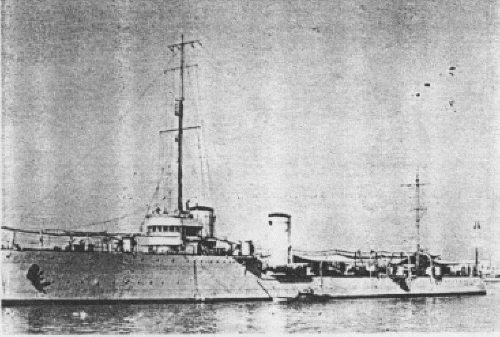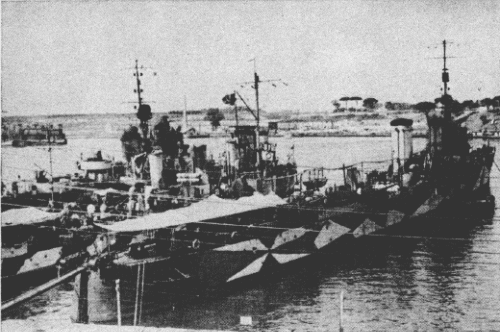
NAVYPEDIA
 Support the project with paypal
Support the project with paypal
Photo

Augusto Riboty 1919
Ships
| Name | No | Yard No | Builder | Laid down | Launched | Comp | Fate |
|---|---|---|---|---|---|---|---|
| Carlo Mirabello | MR, MI | Ansaldo, Genova | 21.11.1914 | 21.12.1915 | 24.8.1916 | sunk 21.5.1941 | |
| Carlo Alberto Racchia | Ansaldo, Genova | 10.12.1914 | 2.6.1916 | 21.12.1916 | sunk 21.7.1920 | ||
| Augusto Riboty | RY, RI | Ansaldo, Genova | 27.2.1915 | 24.9.1916 | 5.5.1917 | stricken 1950 |
Technical data
| Displacement normal, t | 1784 |
|---|---|
| Displacement full, t | 1972 |
| Length, m | 101.1 wl 103.4 oa |
| Breadth, m | 9.70 |
| Draught, m | 3.30 normal 3.60 full load |
| No of shafts | 2 |
| Machinery | 2 Parsons steam turbines, 4 Yarrow boilers |
| Power, h. p. | 44000 |
| Max speed, kts | 35 |
| Fuel, t | oil 386 |
| Endurance, nm(kts) | 2300(12) |
| Armament | Carlo Mirabello: 8 x 1 - 102/35 S1914-1915, 2 x 1 - 76/40 Ar1916, 2 x 1 - 6.5/80, 2 x 2 - 450 TT, 100 mines Carlo Alberto Racchia: 1 x 1 - 152/40 A1899, 7 x 1 - 102/35 S1914-1915, 2 x 1 - 76/40 Ar1916, 2 x 1 - 6.5/80, 2 x 2 - 450 TT, 100 mines Augusto Riboty: 1 x 1 - 152/40 A1899, 7 x 1 - 102/35 S1914-1915, 2 x 1 - 76/40 Ar1916, 2 x 1 - 6.5/80, 2 x 2 - 450 TT, 120 mines |
| Complement | 169 |
Standard scale images

Augusto Riboty 1942

Carlo Mirabello 1916

Augusto Riboty 1942
Graphics
Project history
The ships, which occurrence directly was linked to the effect called in due time by British scout Swift. He did not receive further development in the homeland, but made the big impression upon Italians, in which judgement she ideally approached for actions on the narrow Mediterranean theatre. In 1913-1915 in Italy first scouts of Poerio class were built, with approximately 1000t displacement. Before their completion, in 1913 working out of project of larger ship of this type has begun. Creation of rather solid 5000t scout with light armour was originally provided, however for financial reasons from this "almost a cruiser" have refused in favour of project of much more modest ship designed by Ansaldo (though at that time destroyers of the similar dimensions served only in Chilean and British fleets). Increased, in comparison with Poerio, almost in one and a half time displacement has gone on placing of more powerful machinery, eight (on two more) 102/35mm guns and 2 twin 450mm TTs. In total in 1916-1917 three ships were built. Shortage of light cruisers has forced to install on two ships heavy 152mm guns, however experience has appeared unsuccessful: 6`` guns had low firing rate and besides called strong concussion of the hull. In 1919 they were removed.
These ships were commissioned as scouts, reclassified as light scouts in July, 1921 and as destroyers in September, 1938.
Modernizations
1917, Carlo Mirabello: - 1 x 1 - 102/35; + 1 x 1 - 152/47 G. L/50 K.10
1919, all: - 1 x 1 - 152/40(45); + 1 x 1 - 102/35 T1914
1920 - 1922, both survived: - 8 x 1 - 102/35; + 8 x 1 - 102/45 Schneider-Canet 1917
1922 - 1923, both survived: - 2 x 1 - 76/40; + 2 x 1 - 40/39 Vickers-Terni 1917
1925, Carlo Mirabello: + seaplane (temporarily for a short period)
1942, Augusto Riboty: - 2 x 1 - 102/45, 2 x 1 - 6.5/80; + 1 x 1 - 40/39 Vickers-Terni 1917, 2 x 1 - 8.80
1943, Augusto Riboty: - 2 x 1 - 102/45, 3 x 1 - 40/39, 2 x 2 - 450 TT; + 6 x 1 - 20/70 Oerlikon, DCTs
Naval service
21.7.1920 Carlo Alberto Racchia was sunk on Russian mine off Odessa (Black sea). Carlo Mirabello was lost 21.5.1941 on a mine laid by British minelayer Abdiel in Ionian sea.
 HOME
HOME FIGHTING SHIPS OF THE WORLD
FIGHTING SHIPS OF THE WORLD ITALY
ITALY TORPEDO SHIPS
TORPEDO SHIPS CARLO MIRABELLO flotilla leaders (1916 - 1917)
CARLO MIRABELLO flotilla leaders (1916 - 1917)

